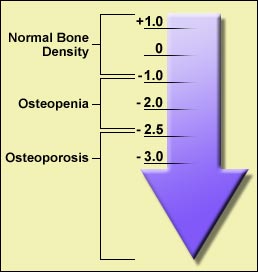 On the T-score scale, 0 represents normal, healthy bone density of a 30-year-old person (the age of peak bone density). T-scores above 0 and slightly below 0 are within the normal range. Your score will tell you how far you are above or below peak bone density. Think of it working like a temperature scale. A temperature of -2 is lower than a temperature of -1. In the same way, a T-score of -2.3 shows lower bone density than a score of -1.8. The T-score is a radiographic diagnosis, meaning it is an X-ray diagnosis and doesn’t imply anything about the cause of osteoporosis.
On the T-score scale, 0 represents normal, healthy bone density of a 30-year-old person (the age of peak bone density). T-scores above 0 and slightly below 0 are within the normal range. Your score will tell you how far you are above or below peak bone density. Think of it working like a temperature scale. A temperature of -2 is lower than a temperature of -1. In the same way, a T-score of -2.3 shows lower bone density than a score of -1.8. The T-score is a radiographic diagnosis, meaning it is an X-ray diagnosis and doesn’t imply anything about the cause of osteoporosis.p-DEXA
- If your T-score is below -1, you should get a central DEXA scan.
- If you have several risk factors for osteoporosis, you may also be referred for a central scan even if your T-score is above -1.
- The p-DEXA should not be used to diagnose osteoporosis or osteopenia.
Central DEXA
- A T-score of -1 to 0 and above is considered normal bone density.
- A T-score between -1 and -2.5 is diagnosed as osteopenia. A score of -2.5 or below is diagnosed as osteoporosis.
There are some conditions, such as arthritis, that can make your T-score higher, or better, than it actually is. It is important that a qualified physician interpret your T-score accurately.
